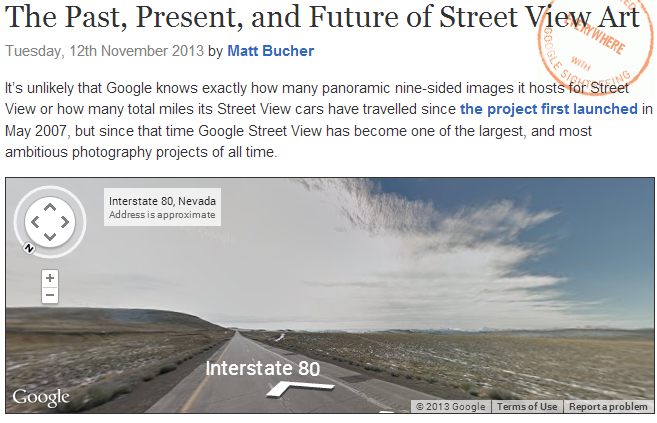Posted: November 11th, 2014 | Author: Matt | Filed under: personal | Tags: 88thDivision, army, Belan, Bucher, bugler, family, LSB, WWI | 1 Comment »
This Veteran’s Day I find myself thinking of a man I never met: my great-grandfather Leo Steven Bucher. He was born in 1890 in Berlin, Germany, and died in 1955 in Dallas, Texas. His parents were named Paul and Elisabeth Belan, and they emigrated to the US in December 1901. They settled in Chicago, working menial jobs in factories and restaurants, but Leo escaped. Sometime between 1906 and 1907 he jumped on a freight train and began tramping around the United States. (I’m condensing some of this story here.) In 1908 he fell ill while riding a train across northern Missouri and hopped off near a tiny town called Powersville. There he was sheltered and raised by a childless couple: Reuben T. and Alice A. Bucher. The Buchers formally adopted Leo at the age of 21 and he went into business with his adopted father: R.T. Bucher & Son. Together they owned several businesses in Powersville including a mercantile, a Sinclair filling station, and a restaurant. Reuben was active in the small Masonic lodge in Powersville and had his son initiated into the lodge in 1913. (In 1905, Reuben and Alice Bucher helped form Order of the Eastern Star Chapter #278 in Powersville, Missouri. They were both charter members and Alice was installed as the Chapter’s first Associate Matron.)
From 1914-1916 Leo Steven attended Chillicothe Business College (in Missouri) and the N.E. Missouri State Teacher’s College (now called Truman State University) in Kirksville, Missouri, studying business and mathematics.
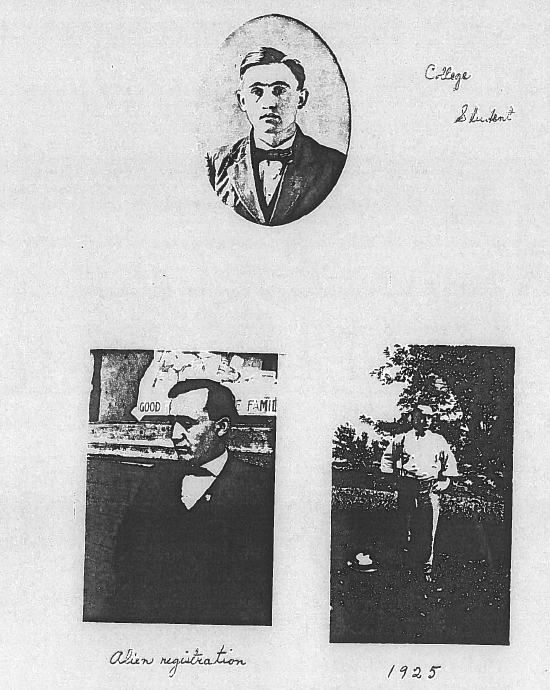
The United States formally declared war on Germany on April 6, 1917. One month later President Wilson enacted a draft, requiring all males age 21-30 to register for service. Leo Steven Bucher was drafted into the US Army on June 5, 1917. He was sent to Camp Dodge, Iowa, but was sent back to Powersville because he was still a German citizen. He was not allowed to enlist and was thrown in jail. The problem was he had no proof of legal US residency, only an alien registration card and his adoption papers. His adopted father Reuben intervened on his behalf and after several tense days he was released and allowed to enlist before the next expansion of the draft. Leo S. Bucher officially entered the army on May 25, 1918. He was conveniently made a US citizen at the Polk County Court House in Des Moines on June 13, 1918.

[courtesy of David Bucher]
At Fort Dodge, Leo S. Bucher (above, in uniform) was given the rank of Bugler, at that time equivalent to Private. Here is his Infantry Drill Regulations manual which outlines the duties of the Bugler and includes sheet music for different calls.
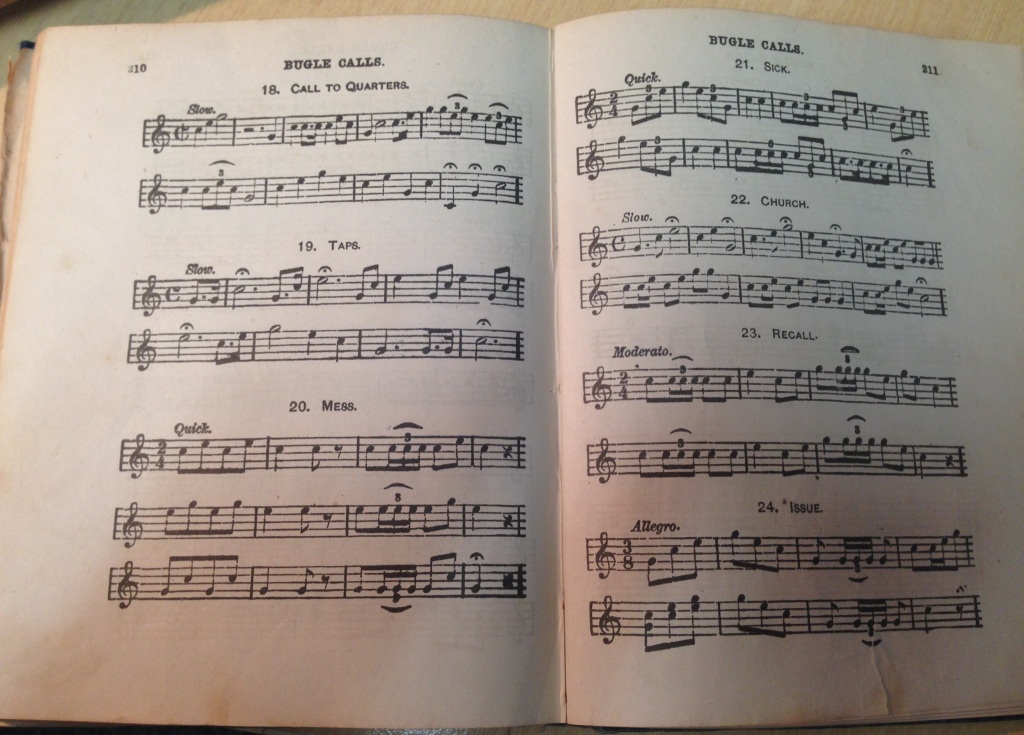
[courtesy of James Bucher]
Here is his bugle:
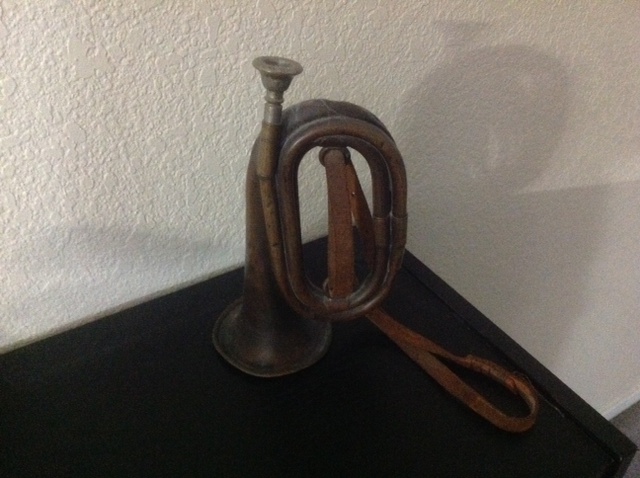
[courtesy of David Bucher]
The soldiers at Camp Dodge were almost all residents of Iowa and northern Missouri. They were part of the Army’s 88th Division and Leo was assigned to C Company, 351st Infantry, 88th Division (Clover Leaf Division) “ part of the AEF, American Expeditionary Force. There is an excellent history of the 88th Division in World War I here:
http://distantcousin.com/Military/wwi/units/usa/88thDivision/index.html
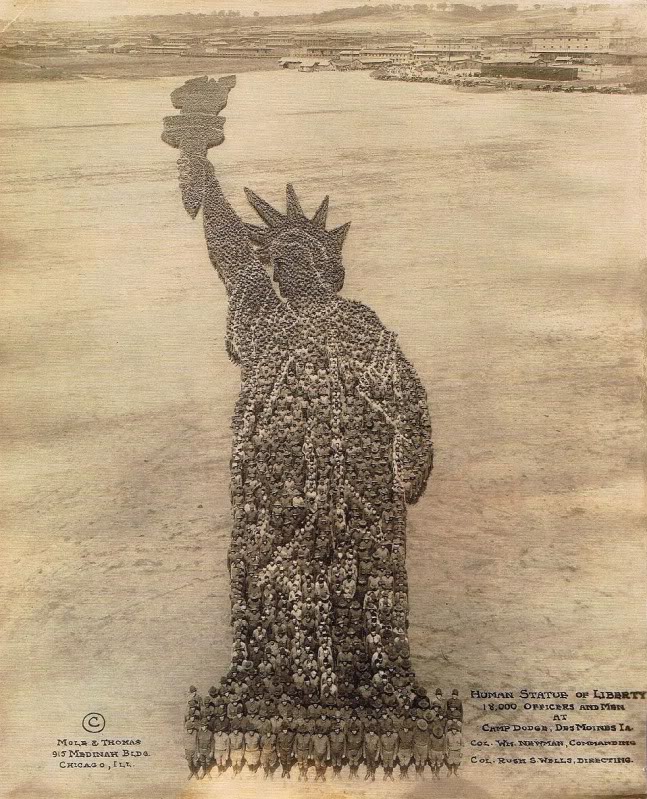
[Human Statue of Liberty – 18,000 officers and men at Camp Dodge, Des Moines, IA, courtesy of Wikipedia]
Company C shipped out to France on August 16, 1918, arriving in Le Havre on September 4. The Division moved by rail from Le Havre to Semur, Cote d’Or, and then to Belfort, France, freeing up the 29th Division to capture enemy artillery positions in the area. In October 1918 Leo was wounded by bomb shrapnel outside of Gommersdorf, France (Southern Sub-Sector) and recovered at a nearby farmhouse. By the time he returned to the 351st Infantry at Belfort, armistice had been declared (November 11 – 96 years ago today) and the war was over. The 88th Division spent the next nine months in France demobilizing, training, attending schools, playing sports, staging plays, and preparing for their return to the United States.
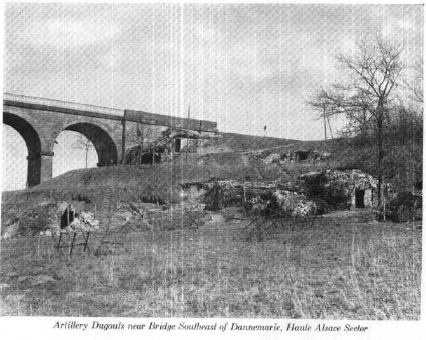
Near the end of their demobilization, the 88th Division spent several weeks in Paris sightseeing and celebrating. I am fortunate to have with me a postcard that Leo Steven Bucher sent to his father Reuben from Paris:
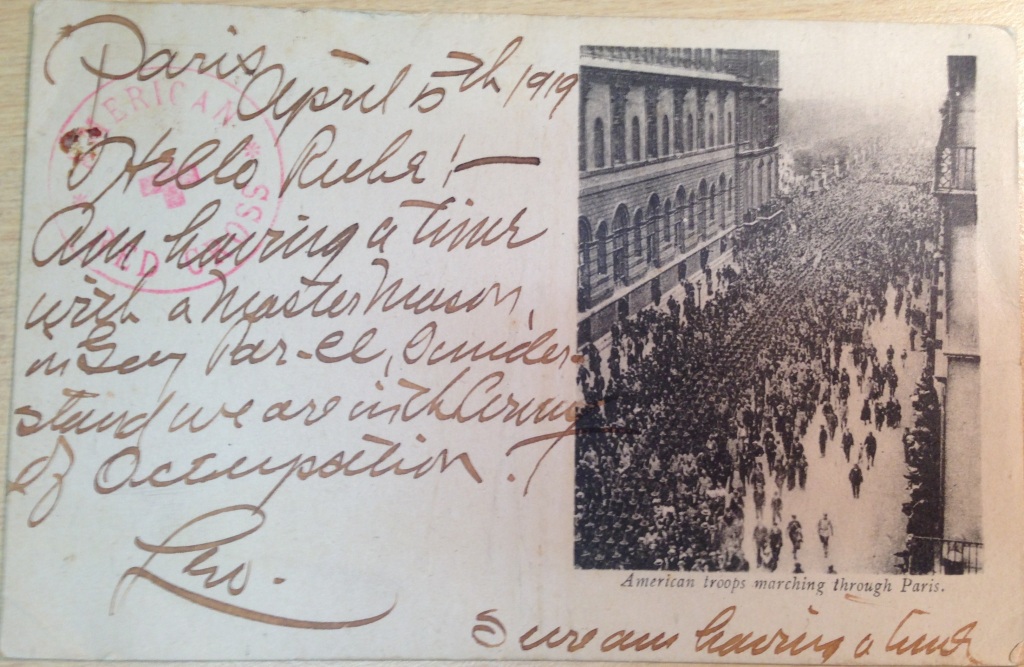
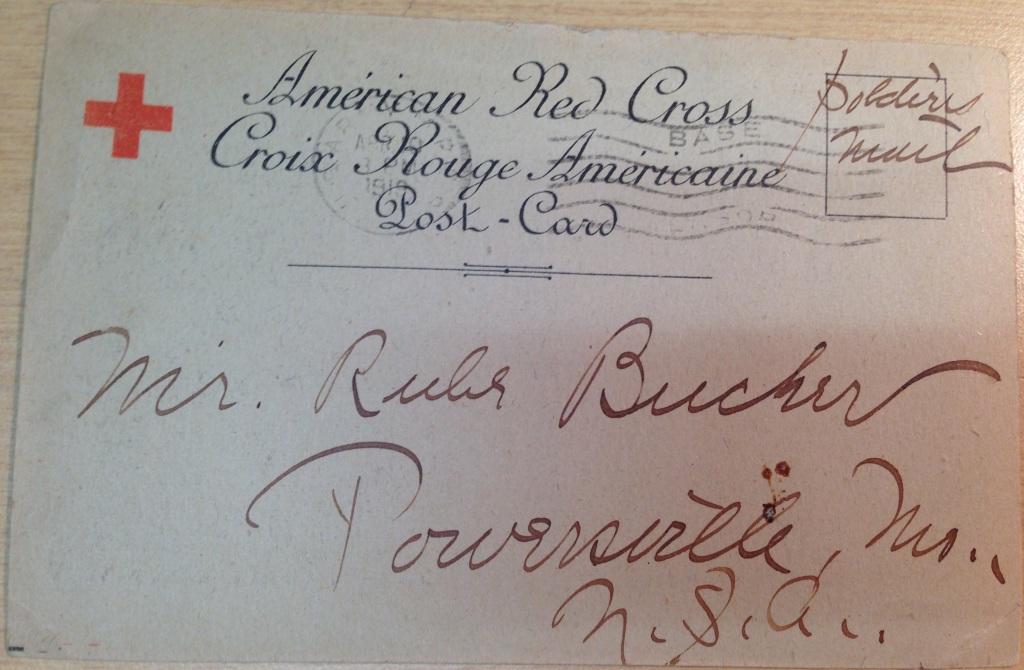
[Paris, April 5th, 1919
Hello Rube!
Am having a time with a Master Mason in Gay Par-ee! Understand we are in the Army of Occupation.
Leo.
Sure am having a time]
He returned to the United States on May 31. On June 9, 1919, he was formally discharged from the military at Camp Zachary Taylor in Louisville, Kentucky. {The novelist F. Scott Fitzgerald also trained at Camp Zach Taylor and mentions it in The Great Gatsby.}
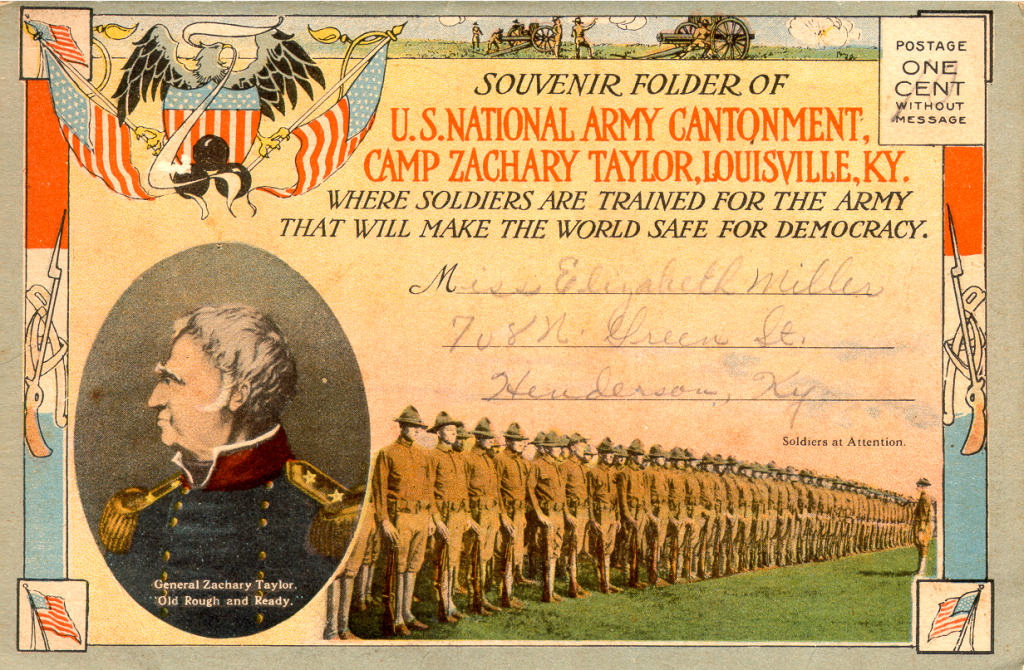
After he returned to Powersville, he met a young Iowa girl named Mary and the two were married in Centerville, Iowa, on May 20, 1924. He was 33, she was 23. They had three children: David Reuben, born 1925, Alice Allene, born 1926, and my grandfather, Leo Warren, born 1929. Reuben entered the Army in March, 1943 and after 20 years service in the medical corps, he was discharged in 1963. Leo Warren entered the Army on November 5, 1950 at Fort Hood, Texas, and was discharged November 28, 1951 at Camp Polk, Louisiana. He served in the 193rd Heavy Tank Battalion.
There is much more to the story of Leo Steven Bucher and I am working on a longer project about his life. But today I wanted to remember him as a war veteran.

Posted: September 24th, 2014 | Author: Matt | Filed under: personal | Tags: DeMolay, Denison, FoundersCross, FrankSLand, Masons, MKT, Railroad, RobertArthur, Texas | 4 Comments »
As a Senior DeMolay, I was intrigued by Seth Anthony’s quest to track down all 137 recipients of the DeMolay Founder’s Cross. The Founder’s Cross was presented by Dad Frank S. Land, founder of the Order of DeMolay, to individuals personally loyal to him. After Dad Land’s death in 1959, no further Founder’s Crosses were awarded. The first Founder’s Crosses were awarded in 1937. Its relative scarcity, and the high profile of many recipients, makes it perhaps the most prestigious award in the history DeMolay.
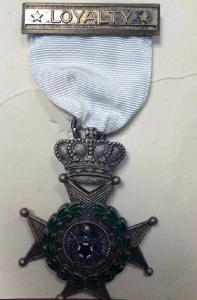
In Seth Anthony’s spreadsheet of recipients, one name stood out to me: Robert T. Arthur. It was notable not because I knew Dad Arthur—he died in 1949—but because he was a resident of Denison, Texas.
My family is from Denison. I went to Kindergarten and first grade there, my brother was born there, my mom, both my grandmothers, and many aunts and uncles still live there. It is as much of a homeland as I’ve ever had. But I know they have not had a DeMolay chapter there in a very long time. I joined the Order of DeMolay in Texas (Tyler) in 1992, and the chapter in Denison was a distant memory even then.
I considered myself familiar with the history of Texas DeMolay, but I had never heard of Dad Arthur. So I enlisted the help of everyone I could find to help track down some vital details about Robert T. Arthur on the distant hope that he might have some surviving relatives who could tell us more about him or what happened to his Founder’s Cross.
One individual, in particular, stepped forward to assist me in this search: Jim Sears. To him, I owe many thanks for tracking down these newspaper articles. His research skills are second-to-none. All of the photos below are a product of his research. Thank you, Jim.
The Railroad Man
Robert T. Arthur was born in Missouri in 1867. His family moved to Pilot Point, in Denton County, Texas, when he was young. Pilot Point is the oldest settlement in Denton County. It is still an operating city (unlike nearby Pilot Grove, birthplace of Benny Binion), and is still associated with horse breeding. Arthur graduated from Denton Normal school (now called the University of North Texas). He then worked in Denton as a school teacher before moving to Denison to take a job with the Katy Railroad in 1889. He worked as a conductor on passenger rail lines for over 50 years. In 1893, at the age of 26, he was elected an officer (Senior Conductor) in the Denison Division of the Order of Railway Conductors (the union representing passenger rail workers).
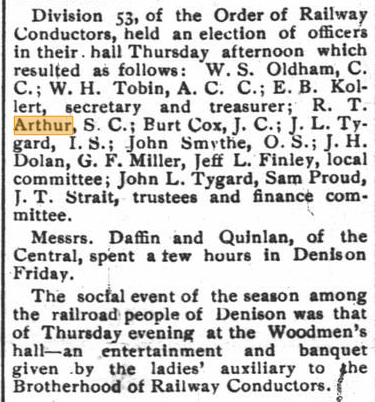
These newspaper articles are sometimes hard to read (and the text should be indexed by search engines) so I will transcribe them throughout.
[Sunday Gazetteer, Denison Texas, December 31, 1893
Division 53, of the Order of Railway Conductors, held an election of officers in their hall Thursday afternoon which resulted as follows: W.S. Oldham, C.C.; W.H. Tobin, A.C.C.; E.B. Kollert, secretary and treasurer; R.T. Arthur, S. C., Burt Cox, J.C.; J.L. Tygard, I.S.; John Smythe, O.S.; J.H. Dolan, G.F. Miller, Jeff L. Finley, local committee, John L. Tygard, Sam Proud, J.T. Strait, trustees and finance committee.
Messrs. Daffin and Quinlan, of the Central, spent a few hours in Denison Friday.
The social event of the season among the railroad people of Denison was that of Thursday evening at the Woodmen’s hall, an entertainment and banquet given by the ladies’ auxiliary to the Brotherhood of Railway Conductors.]
The ritual for the ORC was very similar to a Masonic ceremony, so it’s not surprising that these men were members of several other fraternal organizations. Here is an example of an ORC membership card around the time Arthur joined the Brotherhood:
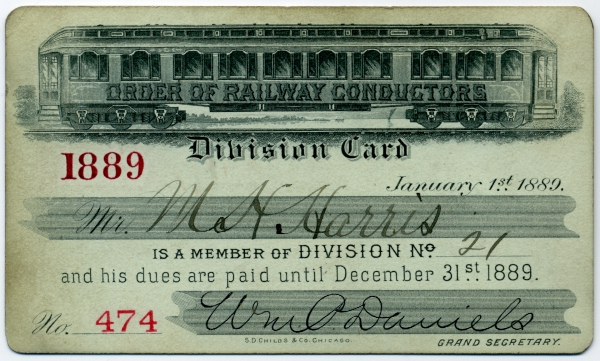
[image via https://www.flickr.com/photos/aemays/5618961385/]
R.T. Arthur married Ms. Lenora Tipton in Denison on July 22, 1891. The couple had three daughters: Faye, who died in infancy; Maude, who died in 1916 at age 24, and Marie, who later married Roy Miller. Robert and Lenora celebrated 50 years of marriage in Denison in 1941. He was the organizer and first advisor to the Denison Chapter of DeMolay, founded in 1921. Much of this information is gleaned from the 1941 newspaper article below.

[From The Denison Press, July 22, 1941
Mr. and Mrs. R.T. Arthur were celebrating their golden wedding Tuesday at their home, 1023 West Morton, while their daughter, Marie and her husband, Roy Miller, were observing their second anniversary. Due to the health of Mrs. Arthur, there will be no formal gathering. Later in the fall the Arthurs plan a trip to California.
Mrs. Arthur is the former Lenora Tipton, daughter of the late Mr. and Mrs. J.I. Tipton, who operated a farm east of Denison after moving here from Kansas. Mrs. Arthur was born in Illinois. She was married at the age of 17 to Robert T. Arthur, then a young Katy railroad man, just arrived from a school teacher’s job in Denton county. He is a graduate of what was then Denton Normal. He was born in Missouri, but moved to Pilot Point with his family when he was a small boy.
The couple married in Denison July 22, 1891, at the home of an aunt, now deceased. They had three children, all girls. Faye Arthur died in infancy. Miss Maude Arthur died in Denison in 1915. Miss Marie Arthur became the wife of W. Roy Miller on her parents’ anniversary two years ago.
Mr. and Mrs. Arthur have been active in the Order of Eastern Star and the Presbyterian Church. Mr. Arthur belongs to a number of Masonic bodies including local chapters and the Shrine, Hella Temple, Dallas, and is a 33rd degree Mason, participating in the activities of a group of 33rd members in Dallas. Mr. Arthur organized the Denison chapter of DeMolay and is active in the affairs of the Shrine hospital at Dallas.
Mrs. Arthur’s hobbies are fancy needle work and flower culture. She is a member of the Denison Garden club and specializes in flower arrangement.
Mr. Arthur’s railroad career dates back to the days when Denison was a wild and wooly frontier town. He has served almost half a century with the Katy and continues his passenger run as a conductor.]
Through his travels as a railroad conductor, R.T. Arthur was able to travel across Texas at free or reduced rates, easily attending Scottish Rite, Shrine, and DeMolay meetings in Dallas and beyond.
It’s telling that a man, like Frank S. Land himself, who had no sons of his own, organized a group of young men into a fraternal organization that was a model for others. What tragedy to bury two daughters.
His surviving daughter, Marie, married Roy Miller and taught at Denison High School for many years.
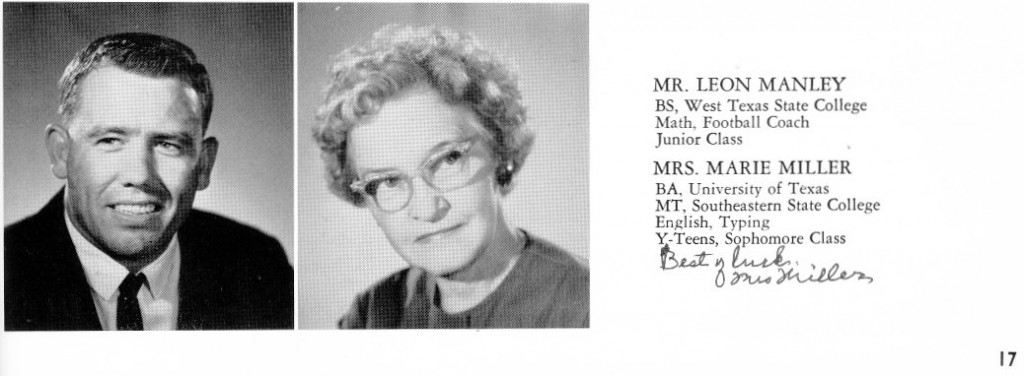
She passed away in 1991, leaving Robert T. Arthur with no living descendants.
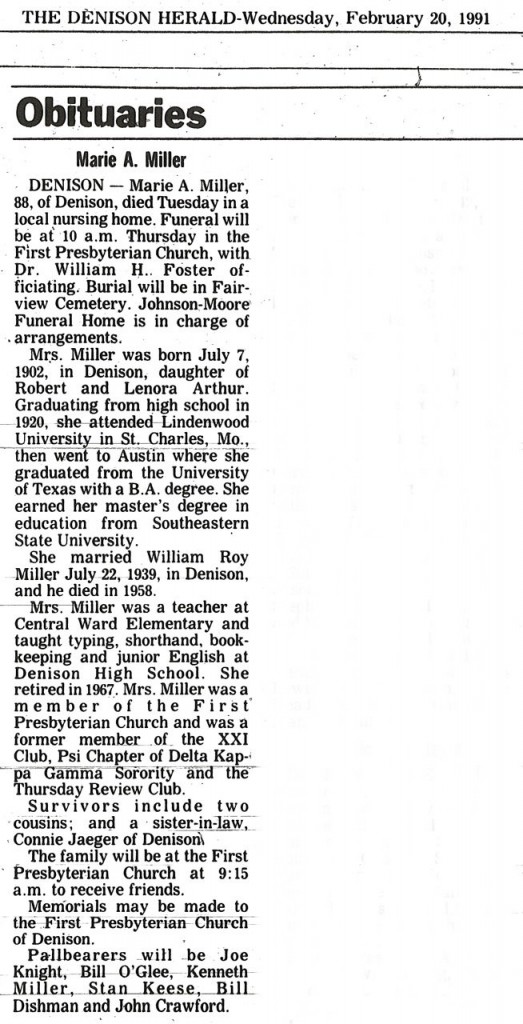
Denison DeMolay
The Order of DeMolay for boys was organized Frank S. Land in Kansas City, Missouri. The first meeting was held March 24, 1919. More chapters were quickly founded across the country.
The chapter in Denison, Texas, was organized in January 1921. It was the 200th chapter founded, with Letters Temporary granted on January 28, 1921. Denison was one of the first chapters of DeMolay in Texas. Ameth Chapter, in El Paso, was the first: it was founded in 1920.
The Denison High School Yearbook from 1937 includes this page of the members and a brief history of the chapter.
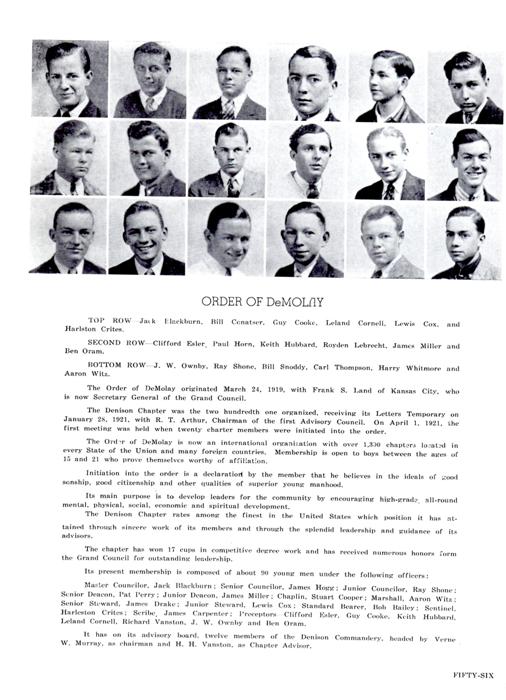
[Denison, Texas, High School Yearbook, 1937
ORDER OF DeMOLAY
TOP ROW: Jack Blackburn, Bill Conatser, Guy Cooke, Leland Cornell, Lewis Cox, and Harlston Crites
SECOND ROW: Clifford Ealer, Paul Horn, Keith Hubbard, Royden Lebrecht, James Miller, and Ben Oram
BOTTOM ROW: J.W. Ownby, Ray Shone, Bill Snoddy, Carl Thompson, Harry Whitmore, and Aaron Witz
The Order of DeMolay originated March 24, 1919, with Frank S. Land of Kansas City, who is now Secretary General of the Grand Council.
The Denison Chapter was the two hundredth one organized, receiving its Letters Temporary on January 28, 1921, with R.T. Arthur, Chairman of the first Advisory Council. On April 1, 1921, the first meeting was held when twenty charter members were initiated into the order.
The Order of DeMolay is now an international organization with over 1330 chapters located in every State of the Union and many foreign countries. Membership is open to boys between the ages of 15 and 21 who prove themselves to be worthy of affiliation.
Initiation into the order is a declaration by the member that he believes in the ideals of good sonship, good citizenship and other qualities of superior young manhood.
Its main purpose is to develop leaders for the community by encouraging high-grade, all around mental, physical, social, economic and spiritual development.
The Denison Chapter rates among the finest in the United States which position it has sustained through sincere work of its members and through the splendid leadership and guidance of its advisors.
The chapter has won 17 cups in competitive degree work and has received numerous honors from the Grand Council for outstanding leadership.
Its present membership is composed of about 50 young men under the following officers:
Master Councilor, Jack Blackburn; Senior Councilor, James Hogg; Junior Councilor, Ray Shone; Senior Deacon, Pat Perry; Junior Deacon, James Miller; Stuart Cooper, Chaplain; Aaron Witz, Marshal; James Drake, Senior Steward; Lewis Cox, Junior Steward; Bob Bailey, Standard Bearer; Harleston Crites, Sentinel; James Carpenter, Scribe; Preceptors: Clifford Ealer, Guy Cooke, Keith Hubbard, Leland Cornell, Richard Vanston, J.W. Ownby, and Ben Oram.
It has on its advisory board twelve members of the Denison Commandery, headed by Verne W. Murray, as chairman and H.H. Vanston as Chapter Advisor.]
Here are some of the Denison High School year book (The Yellowjacket) pages for the DeMolay club in the 1920s. Here is 1924:
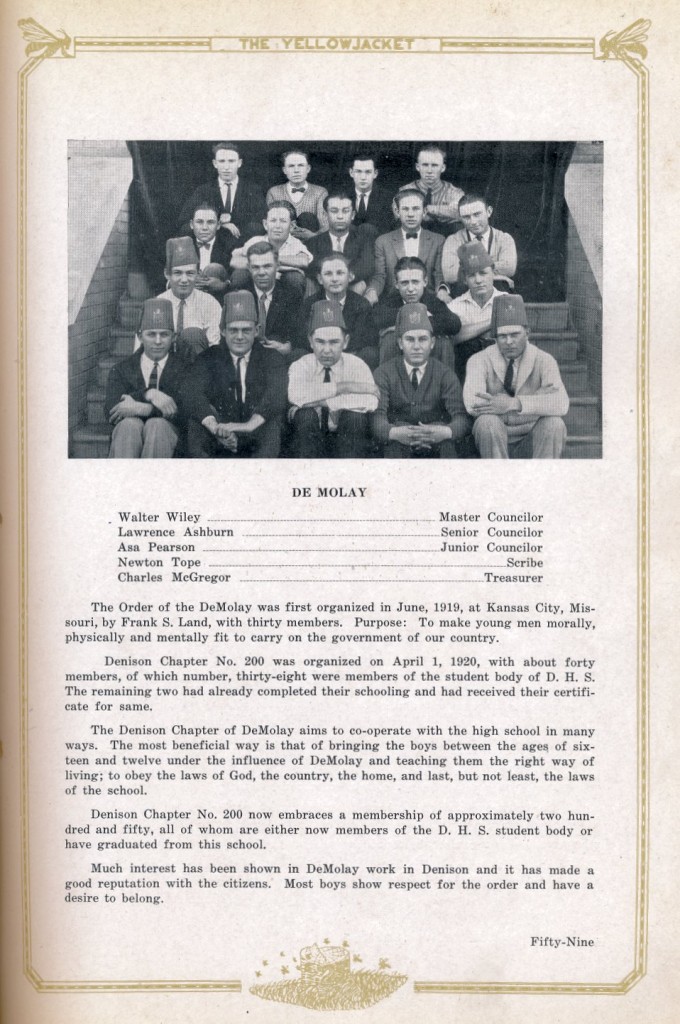
And here is 1925: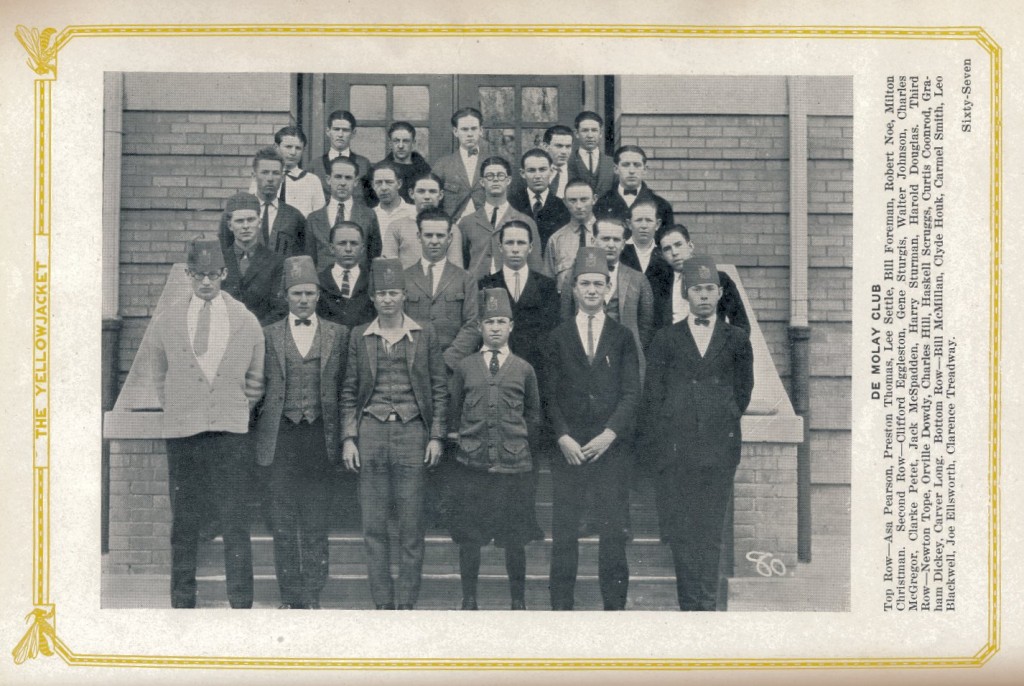
As far as I can tell, the chapter was active and productive from 1921 until the 1960s. One of the high points in the life of the chapter came in 1937 when Dad Arthur was awarded the Founder’s Cross by Frank S. Land at the Conclave in Waco.

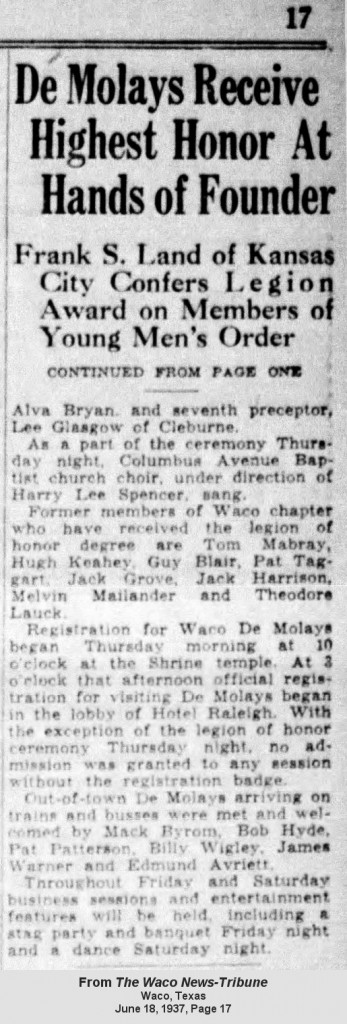
[Waco News-Tribune, June 18, 1937
DeMolays Receive Highest Honor at Hands of Founder
Frank S. Land of Kansas City Confers Legion Award on Members of Young Men’s Order
3 Wacoans given Special Awards
Alva Bryan, Robert Arthur and Lee Dewey Are Handed Crosses in Recognition of Work
The legion of honor, the highest distinction which a DeMolay can receive, was conferred on five young men of Texas last night by Frank S. Land of Kansas City, founder of the Order of DeMolay. Mr. Land also presented for the first time in the history of the order, his personal founders cross to three men, Alva Bryan, Robert Arthur, and Lee Dewey in recognition of their faithful work with DeMolay in Texas.
Those who received the legion of honor for outstanding leadership in some worthwhile endeavor are as follows: Mandell H. Cline, Mexia; Elwood Henry Brown, Houston; Maxwell Goodman, Fort Worth; Randolph Jackson, Hillsboro, and Robert Lewis, Hillsboro.
Altar is in White
At an altar of white, surrounded by white candles, the five candidates for the degree knelt and took their vows from Mr. Land. Each preceptor placed a bouquet on the altar. A choir furnished the music. This degree was the first event of a three-day session of the state DeMolay conclave, which continues through Saturday. Today there will be the business sessions until 5:30 p.m. at which time there will be a downtown parade featuring stunts, and each chapter in Texas will be represented. A banquet and three-hour floor show will be presented tonight starting at 7:30 o’clock for all registered DeMolays.
Officers in Ceremony
Officers who conducted the ceremony were as follows: Commander in the east, Frank S. Land; Commander in the west, James Blundell; commander in the south, Pat Taggart; herald, Sidney Dobbins; grand marshal, J. Floyd Smith; grand chaplain, Jack H. Harrison; first preceptor, R.L. Othling; second preceptor, Hugh Keahey; third preceptor, George Denton; fourth preceptor, Billy Smith; fifth preceptor, George Lovell; sixth preceptor, Alva Bryan; and seventh preceptor, Lee Glasgow of Cleburne.
As apart of the ceremony Thursday night, Columbus Avenue Baptist church choir, under direction of Harry Lee Spencer, sang.
Former members of Waco chapter who have received the Legion of Honor degree are Tom Mabray, Hugh Keahey, Guy Blair, Pat Taggart, Jack Grove, Jack Harrison, Melvin Mailander and Theodore Lauck. Registration for Waco DeMolays began Thursday morning at 10 o’clock at the Shrine temple. At 3 o’clock that afternoon official registration for visiting DeMolays began in the lobby of Hotel Raleigh. With the exception of the legion of honor ceremony Thursday night, no admission was granted to any session without the registration badge.
Out-of-town DeMolays arriving on trains and busses were met and welcomed by Mack Byrom, Bob Hyde, pat Patterson, Billy Wigley, James Warner, and Edmund Avriett.]
This event marked the first time that Dad Land had awarded a Founder’s Cross. If they went alphabetically, Robert T. Arthur might have received the very first Founder’s Cross, though Alva Bryan was Executive Officer at the time and might have come first in precedence for Dad Land. It is a remarkable honor that Texas DeMolay Conclave hosted Dad Land personally awarding the Legion of Honor and Founder’s Crosses on this day in 1937.
Thanks again to Jim Sears for providing these images and researching all of this with me.
If you have any information about Robert T. Arthur, Marie Miller, Denison DeMolay, or the Founder’s Cross, please contact me at matt@mattbucher.com
Posted: February 23rd, 2013 | Author: Matt | Filed under: personal | Tags: books, novels, reading, recommended, underappreciated | No Comments »
These are some of the books that I often find myself recommending to people. Usually these are people who have read David Foster Wallace, Cormac McCarthy, Don DeLillo, Cloud Atlas, and Moby-Dick (or whatever) and are interested in something a little more offbeat. But these aren’t too offbeat. You’ve likely already read at least one or more of these, too.
1. Log of the SS The Mrs Unguentine by Stanley Crawford
This short novel (novella?) tells the story of a marriage aboard a gigantic barge. Like most of these books, it’s hard to accurately describe. The narrator has a unique voice and the fact that it’s set aboard a ship calls to mind a postmodern Melville and Waterworld. It’s the kind of book that other writers read and think “Damn, I wish I’d written that.”
2. This is Not a Novel by David Markson
Markson’s Wittgenstein’s Mistress got a huge plug from David Foster Wallace, but Markson’s index-card tetraology of Reader’s Block, This is Not a Novel, Vanishing Point, and The Last Novel, are to me, more rereadable. (I even started a twitter account dedicated to them.) Evan Lavender-Smith called them “like porn for English majors.”
3. From Old Notebooks by Evan Lavender-Smith
Speaking of EL-S, his book, From Old Notebooks, takes the form of Markson’s books (although he also traces the form back to Evan S. Connell’s Notes from a Bottle Found on the Beach at Carmel) and updates it, giving us insight into the modern mind of the writer. If you liked Markson’s books, you’ll love Evan Lavender-Smith’s. I can’t say enough good things about it. Read biblioklept’s review.
4. The Journalist by Harry Mathews
Mathews is best known as the only American OuLiPo member, and all of his work bears some formal mark of constraint, but this novel stands out to me as his best. It’s the story of a journalist trying to make sense of his life and organize his thoughts–and of course, he slowly goes insane. If you liked Wittgenstein’s Mistress and Pale Fire, I am sure that you will like The Journalist.
5. Live Girls by Beth Nugent
This book is seriously, direly under-appreciated. I remember the day the book came out and every year or so since then I go back and read a few pages of it and can’t believe how incredible it is. The characters are strange and quirky and completely original and the story itself is just incredibly heart-rending. By my accounting, Live Girls should be considered one of the best novels published in the 1990s. If you like Steve Erickson or Vollman’s The Royal Family, you’ll probably like this, too, but I wouldn’t limit the appeal of it there.
6. Summer Blonde by Adrian Tomine
Chris Ware’s Jimmy Corrigan is now considered part of the pantheon of not just great graphic novels, but great contemporary novels. I agree and would g0 a step farther to say that fans of Chris Ware need to read Adrian Tomine. Summer Blonde is one of his best, but you can’t go wrong with Shortcomings, or any single edition of his Optic Nerve series. The latest issue of Optic Nerve contains an interesting allegory about art that deserves greater attention outside of comics circles.
7. The Lost Scrapbook by Evan Dara
This is one of the great “big” novels of the 1990s. It’s also probably the least known. Dara, almost certainly a pseudonym, plays with form and voices in a way that calls to mind Gaddis in his prime. The story is almost incidental, but part of it is an ecological thriller.
8. The Last Western by Thomas Klise
This is an obscure novel I learned about from Maria Bustillos on wallace-l. I looked for a cheap copy for years before finally picking one up on ABE for $25. Maria’s appreciation of the book is required reading. I’m certain that a publisher will re-issue it at some point and will make a good profit. The story is about an unlikely hero–a pope from New Mexico.
9. I Know Many Songs But I Cannot Sing by Brian Kiteley
Kiteley’s short novel takes place in Cairo during Ramadan. An American named Ib gets lost and wanders through an almost hallucinatory set of experiences. If you are a fan of Paul Bowles or Amitav Ghosh, you need to read this book. Also recommended is Kiteley’s masterful first novel, Still Life With Insects.
10. The Method Actors by Carl Shuker
Shuker’s novel immediately garnered comparisons to David Foster Wallace and David Mitchell when it was published in New Zealand. The voices and set pieces are dazzling. For me they call to mind the great Henry Green’s books full of characters in medias res, leaving the reader to sort out who is who and what is really going on. Shuker’s other books are also all highly recommended.
11. Super-Cannes by J.G. Ballard
Ballard may be known for Crash, but for me, this book best represents his critique of modern society. The picture he paints of Cannes is a mirror of almost every luxurious suburb and his eye for detail helps create an image that is compelling and abhorrent at the same time.
12. The Story of a Million Years by David Huddle
This one is a little different in that it is a love story, but Huddle deserves to be mentioned alongside Updike or Roth because he is more compassionate and able to craft believable female protagonists. This is not a book I frequently re-read (although it’s short), but one I’m glad I read when I did. I also liked his book La Tour Dreams of the Wolf Girl. My wife, Jordan, gets credit for introducing me to Huddle!





















